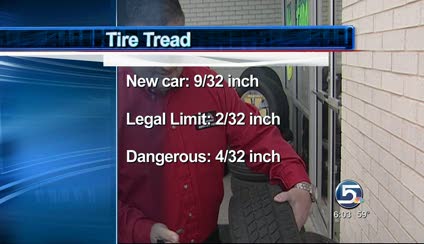Estimated read time: 2-3 minutes
This archived news story is available only for your personal, non-commercial use. Information in the story may be outdated or superseded by additional information. Reading or replaying the story in its archived form does not constitute a republication of the story.
OREM — Stacks of traded-in tires behind the Big-O Tire store tell a grim story: Motorists pinching pennies as they ride out a bad economy are running their tires well beyond legal limits before buying new ones.
Combine overly worn tires with day after day of wet roads in Utah, and the safety hazards skyrocket.
According top Consumer Reports, a tire's tread is usually measured in 1/32 in. increments, and is considered bald when its tread reaches a depth of 2/32 in., the point at which it will no longer pass state inspection.
However, even at 4/32 in., a tire will begin performing worse in the rain, leading to longer distances traveled when trying to stop and increased likelihood for hydroplaning.
New tires will have a depth of approximately 10/32 in.
Hydroplaning is more likely to occur the lower the tread is due to less effective channeling of the water out from under the. The deeper the channel, the better the control.
At 2/32 in., a midsized care will begin hydroplaning at approximately 40 mph. The faster you drive, the more likely it is.
"Tires are a critical safety item," said Utah Highway Patrol Trooper Bryce Ivie as the rain fell Friday on a busy I-15 in American Fork. "They affect the braking and handling ability of the vehicle. In wet weather conditions especially, you can increase the stopping distances by more than double."
Ferdie Brown, a senior franchise business consultant for Big O Tires, said customers coming in for routine maintenance are reluctant to buy new tires, even when told the tread is word beyond legal limits.
"They say 'Hey, I'll take care of that. My car needs to be inspected in a couple of months. I'll take care of it then,'" Brown said.
A new passenger-car tire has a tread depth of about 9/32 inch. Tires are legally worn out when the tread depth is down to 2/32 inch. Using a test familiar to many, that depth is the same as the distance from the top edge of a penny to the top of the image of Abraham Lincoln's head. Law enforcement and the tire industry would like to see the legal limit increased to 4/32 inch, about the distance from the top of a quarter to the top of the image of George Washington's head.
Ivie said tire industry demonstrations he has seen show a tire's control performance decreases by half when tread wear reaches the half-way mark — or about 4/32 inch.
ConsumerReports.org reports that its wet-road tests at half-tread showed vehicles began hydroplaning 3 to 4 mph slower than full-tread tires, and test vehicles took 3 to 6 feet longer to come to a stop from 40 mph.
Utah's safety inspection system is a safeguard against hazardous tires, but not something motorists should rely on to know when their tires need to be replaced. "It's possible for tires to wear out between inspections, so the vehicle owner should check their tires on a regular basis," Ivie said.
Email:sfidel@ksl.com








